
Boyacá is one of the thirty-two departments of Colombia, and the remnant of Boyacá State, one of the original nine states of the "United States of Colombia".

Santander is a department of Colombia. Santander inherited the name of one of the nine original states of the United States of Colombia. It is located in the central northern part of the country, borders the Magdalena River to the east, Boyacá to the south and southeast, the Norte de Santander Department to the northeast, the Cesar Department to the north, the Bolivar and Antioquia Departments to the west. Its capital is the city of Bucaramanga.

Departments of Colombia refer to the administrative divisions of Colombia. As of 2024, the unitary republic is made up of thirty-two departments. Each department has a governor and an assembly, elected by popular vote for a four-year period.
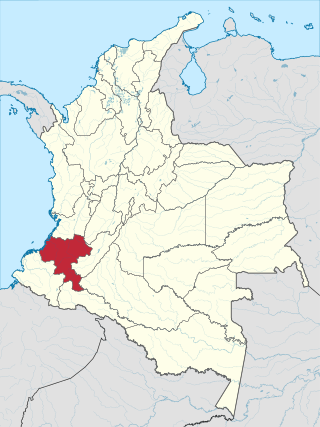
Cauca Department is a department of Southwestern Colombia. Located in the southwestern part of the country, facing the Pacific Ocean to the west, the Valle del Cauca Department to the north, Tolima Department to the northeast, Huila Department to the east, and Nariño Department to the south. Putumayo and Caqueta Departments border the southeast portion of Cauca Department as well. It covers a total area of 29,308 km2 (11,316 sq mi), the 13th largest in Colombia. Its capital is the city of Popayán. The offshore island of Malpelo belongs to the department. It is located in the southwest of the country, mainly in the Andean and Pacific regions plus a tiny part (Piamonte) in the Amazonian region. The area makes up 2.56% of the country.

Cúcuta, officially San José de Cúcuta, is a Colombian municipality, capital of the department of Norte de Santander and nucleus of the Metropolitan Area of Cúcuta. The city is located in the homonymous valley, at the foot of the Eastern Ranges of the Colombian Andes, on the border with Venezuela. It comprises an area of approximately 1119 km2, with an urban area of 64 km2 and a rural area of 1055 km2. The city has a population of 777,106 inhabitants, which makes it the most populous municipality in the department and the sixth most populous municipality in the country. Similarly, its metropolitan area has an approximate population of 1,046,347.

Bucaramanga is the capital and largest city of the department of Santander, Colombia. Bucaramanga has the fifth-largest economy by GDP in Colombia, has the lowest unemployment rate and is the ninth most populous city in the country, with a population of 613,400. Bucaramanga has over 160 parks scattered throughout the city and has been given the nickname "La Ciudad de Los Parques" and "La Ciudad Bonita de Colombia".

Francisco José de Paula Santander y Omaña was a Colombian military and political leader who served as Vice-President of Gran Colombia between 1819 and 1826, and was later elected by Congress as the President of the Republic of New Granada between 1832 and 1837. Santander played a pivotal role in the Colombian War of Independence being one of the main leaders of the Patriot forces and helped lead the Patriot Army alongside Simon Bolivar to victory. He's often credited with creating the legal foundations for democracy in Colombia, as well as creating the country's first system of public education. For these reasons he is considered a National Hero in Colombia and has thus commonly been known as "The Man of the Laws" as well as the "Organizer of Victory".

The Guane were a South American people that lived mainly in the area of Santander and north of Boyacá, both departments of present-day central-Colombia. They were farmers cultivating cotton, pineapple and other crops, and skilled artisans working in cotton textiles. The Guane lived north of the Chicamocha River, around the Chicamocha Canyon in an area stretching from Vélez in the south to the capital of Santander; Bucaramanga in the north. Other sources state their territory did not extend so far north. Guane, a corregimiento of Barichara, Santander, is said to have been the capital of the Guane people.

The Industrial University of Santander, abbreviated in Spanish with the acronym UIS, is a public university, based in a coeducational, and research model. The university serves the Santander Department, being the main campus located in the city of Bucaramanga, Santander, Colombia. The university also has satellite campuses across the department in the cities of Barrancabermeja, Barbosa, Málaga, Piedecuesta, Socorro.
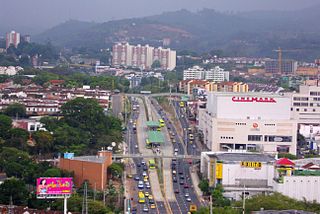
Floridablanca is a municipality in the department of Santander situated at an altitude of 925 metres (3,035 ft) in the Eastern Ranges of the Colombian Andes. It is part of the metropolitan area of the departmental capital Bucaramanga. Floridablanca is known for its parks and the Piedra del Sol, a large rock with spirals and circles carved by the Guane over 1,000 years ago. This city is home of the tallest statue of Jesus Christ in Colombia, "El Santisimo". The statue is 40 metres (130 ft) high and weighs 40 tonnes (88,000 lb). The city is situated along the Ruta Nacional 45A, a branch of the Pan American Highway, connecting the capital Bogotá with Santa Marta at the Caribbean coast and Cúcuta as a gateway to Venezuela. Together with other neighboring municipalities of Bucaramanga, Girón and Piedecuesta, Floridablanca is one of the growth areas for the capital of Santander with numerous constructions happening in recent years.

Barichara is a town and municipality in the Santander Department in northeastern Colombia.
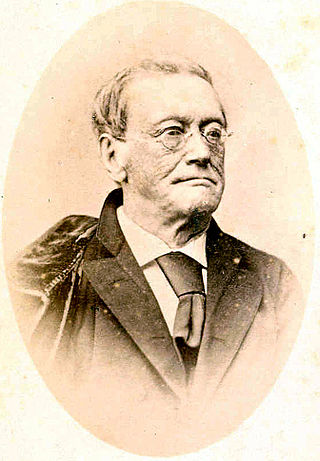
José Ignacio de Márquez Barreto was a Colombian statesman, lawyer and professor, who first served as Vice President of the Republic of the New Granada after being sworn in by congress in 1832, and under the presidency of Francisco de Paula Santander, and subsequently was elected President of the Republic of the New Granada for the presidential term of 1837 to 1841.
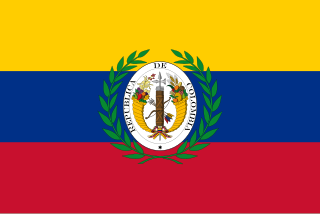
Gran Colombia, or Greater Colombia, officially the Republic of Colombia, was a state that encompassed much of northern South America and part of southern Central America from 1819 to 1831. It included present-day Colombia, mainland Ecuador, Panama, and Venezuela, along with parts of northern Peru, northwestern Brazil, and claimed the Essequibo region. The terms Gran Colombia and Greater Colombia are used historiographically to distinguish it from the current Republic of Colombia, which is also the official name of the former state.
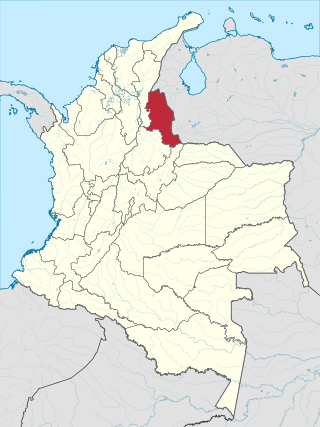
North Santander is a department of Northeastern Colombia. It is in the north of the country, bordering Venezuela. Its capital is Cúcuta, one of the country's major cities.

Flavio Enrique "Kike" Santander Lora is a Colombian-American composer, record producer, arranger and entrepreneur. He is considered to be one of the principal Latino composers of the day, having worked with artists such as David Bisbal, Cristian Castro, Thalía, Chayanne, Natalia Oreiro, Diego Torres, Davi Wornel, Alejandro Fernández, Olga Tañón, Bacilos, José Luis Rodríguez «El Puma» and Gloria Estefan among others. Santander has composed more than 710 songs and has sold over 25 million albums worldwide. His work as songwriter and producer includes themes such as Let's Get Loud by Jennifer Lopez, Abriendo puertas by Gloria Estefan, Me Estoy Enamorando by Alejandro Fernández, Mi Vida Sin Tu Amor by Cristian Castro, and Premonición by David Bisbal, as well as many songs recorded by artists such as Thalía, Natalia Oreiro, Gisselle, Edith Márquez, Luis Miguel, Soledad Pastorutti and the Spanish song for Eurovision Song Contest 2004, amongst others.

Colombia is a country in north-western South America. Colombia is bordered by Venezuela, Brazil, Ecuador, Peru, Panama and the Caribbean Sea and the Pacific Ocean. With a population of over 45 million people, Colombia has the second largest population in South America, after Brazil. The capital is Bogotá.
David Bushnell was an American academic and Latin American historian who has been called "The Father of the Colombianists." Bushnell, one of the first Americans to study Colombia, was considered one of the world's leading experts on the history of Colombia. He regarded it as one of the least studied countries in Latin America by academic scholars in the United States and Europe, and was considered the first American historian to study and introduce Colombian history as an academic field in the United States.

The Cámara de Comercio de Cúcuta or Chamber of Commerce of Cúcuta is a non-profit entity of the government of Colombia, attached to the Ministry of Industry, Commerce and Tourism. The jurisdiction is the city of Cúcuta and its Metropolitan Area.
German Colombians are Colombian citizens of German ancestry. They may be descendants of Germans who immigrated to Colombia from Germany or elsewhere in Europe. Most German Colombians live in the departments of Andean Region and Caribbean Region. Germans have been immigrating to Colombia since at least 16th century. During World War II, thousands of Germans fled to Colombia.

















